Pants are the most exposed apparel that should go through the most wear and tear. So it poses demands to the material selection. In this article, I’ll share with you some key information about pants fabric and you can choose the most suitable one for your pants business.
What should you consider when choosing materials for pants?
Durability and wrinkle resistance
Compared to other garments, pants should be more robust and durable since they are subjected to walking and movement. Meanwhile, if wrinkles appear quickly, it can impact user experience and trust in the brand.
Many fabrics are inherently abrasion-resistant and wrinkle-resistant, such as polyester. You can also enhance fabric wrinkle resistance through the use of chemical agents like wrinkle repellents and shrinkage inhibitors. Or you can add special coatings to the fabric surface to increase the properties.
Breathability
Good breathability helps keep the body dry, prevents excessive sweating, and avoids discomfort. For summer sportswear, materials with good breathability can also help reduce the likelihood of odors, and inhibit the growth of bacteria.
Comfort
Comfort is an essential factor across all clothing categories. It can ensure a soothing experience by using cozy and non-irritating materials. In addition, pants should facilitate unrestricted movement, effectively managing the equilibrium between warmth and flexibility. Or it will result in discomfort during wear.
GSM
The higher the GSM or oz, the heavier the fabric will be, and it will also provide better warmth. GSM choice is mainly based on the season. Pants worn in spring and autumn are generally lighter, with polyester or pure cotton fabrics around 200 GSM. For winter fabrics like corduroy, around 300 GSM to 350 GSM is needed.
10 types of pants material
Different fabrics have various features, so the types and functions of pants made are different.
Cotton
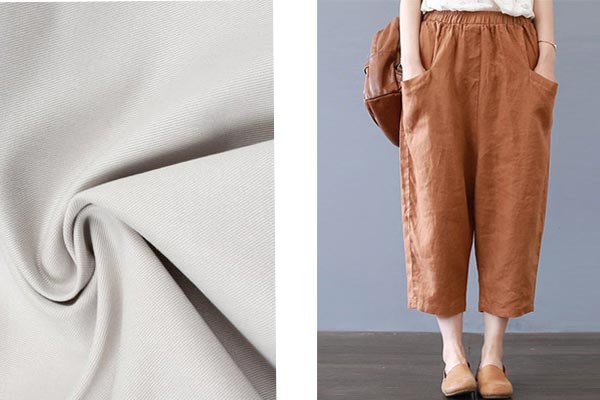
As a natural fabric, cotton is comfortable, lightweight, breathable, and flexible. It doesn’t trap heat or odor, making it versatile for crafting pants suitable for any season or style. It features good moisture-wicking properties, so it is always blended with other materials for sportswear like yoga pants and cycling shorts.
Additionally, cotton is less likely to cause skin irritation, which is why pure cotton fabrics are frequently used in making children’s pants.
Linen
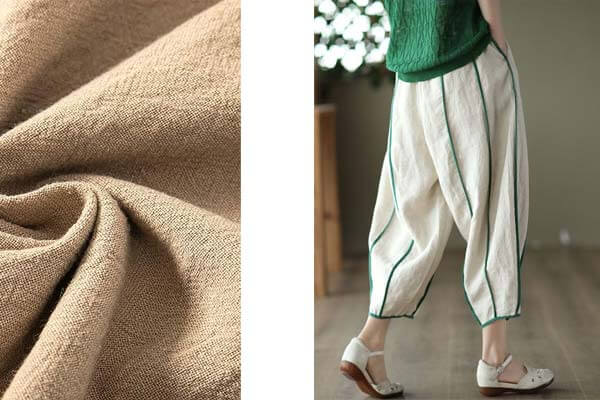
Linen is soft, lightweight, and harmless to the human body. It is becoming increasingly popular to make summer pants such as wide-leg pants. It has high tensile strength and good corrosion resistance. This fabric is also easy to absorb sweat and moisture, which is beneficial for preventing certain skin conditions such as rashes and skin itching.
Linen fabric is easy to dye with high colorfastness, and it is not prone to static electricity and dust absorption. However, linen is prone to wrinkling and deformation.
Silk
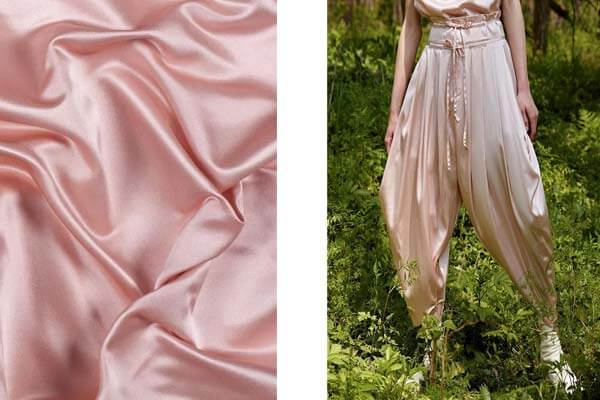
Silk features a lightweight texture, a soft and smooth touch, and exceptional comfort. It’s highly suitable for making wide-leg pants, jumpsuits, and other types during the summer. Its unique sheen and luxurious feel also make it an excellent choice for creating premium trousers. However, this type of fabric lacks durability.
Wool

Wool is widely used in making pants due to its excellent warmth and moisture-absorbing properties. It is commonly used in casual styles, and business styles, such as wool trousers and tweed pants. However, wool can sometimes cause allergies.
The above 4 types are natural fabrics and they all have good breathability. The price of 100% natural fabric is usually higher, so they are often blended with synthetic materials to make pants. Next, I will introduce to you several common types of synthetic materials.
Denim
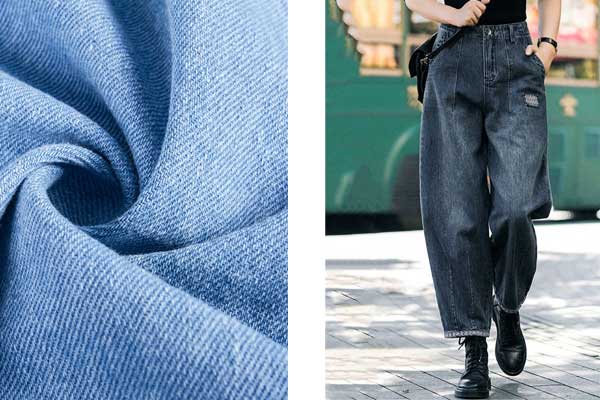
Denim, one of the most common twill-weave fabrics, is a true classic when it comes to everyday, casual trousers. This fabric is usually thick, mid- or heavy-weight, extremely durable, and comfortable to wear.
Some manufacturers may use certain processing techniques, so the density and thickness of denim can be reduced, making it softer and lighter for summer pants. However, this may affect the appearance, texture, and durability of the fabric.
Polyester
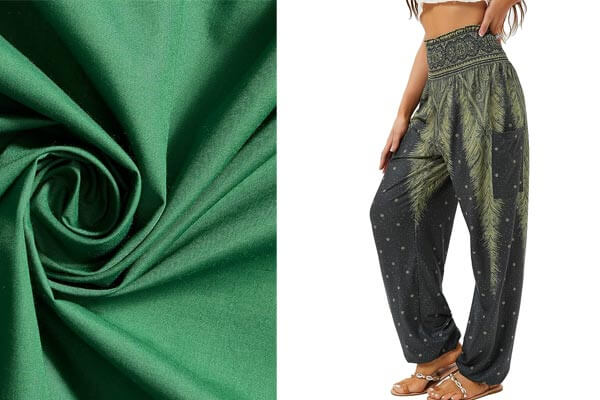
Polyester fiber is the most common material for making pants or trousers. It possesses high abrasion resistance and wrinkle resistance, and its dyed colors are vibrant and not easy to fade. Common types of pants like cargo pants, work pants, activewear, and travel pants are made from polyester.
However, pure polyester fiber has poor breathability and is prone to generating static electricity. It might even cause skin irritation or allergic reactions. That’s why most manufacturers blend it with materials like cotton, spandex, and other fibers to create pants.
Canvas
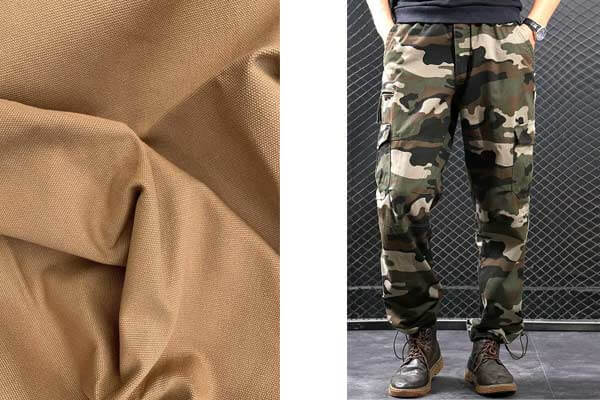
Canvas is a tough and durable fabric, typically made from cotton fibers. It features strong abrasion resistance, sturdiness, and excellent wind and water resistance. This type of fabric is suitable for outdoor and highly active environments. As a result, it is often used in making casual pants, work pants, outdoor trousers, etc.
However, due to its relatively thick texture, it is not suitable for hot seasons or situations requiring high breathability.
Spandex
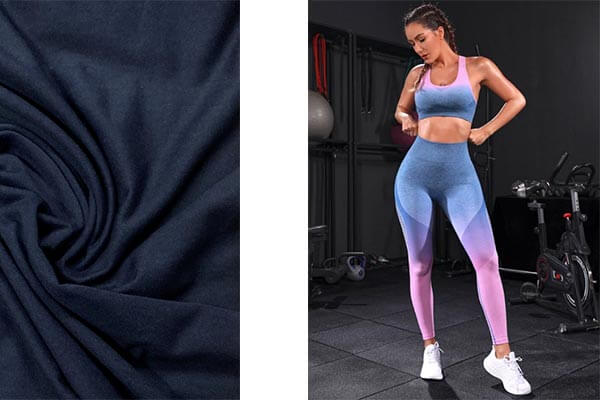
It is also known as elastane and the most common type is Lycra. It possesses high elasticity and resilience, providing excellent stretchability and a snug fit to the body. Therefore, it is often used to make form-fitting pants such as leggings, activewear, jeans, etc. for providing comfortable contouring and flexible movement capabilities.
In addition, it features lightweight comfort and good breathability, with high durability and resistance to deformation.
Rayon
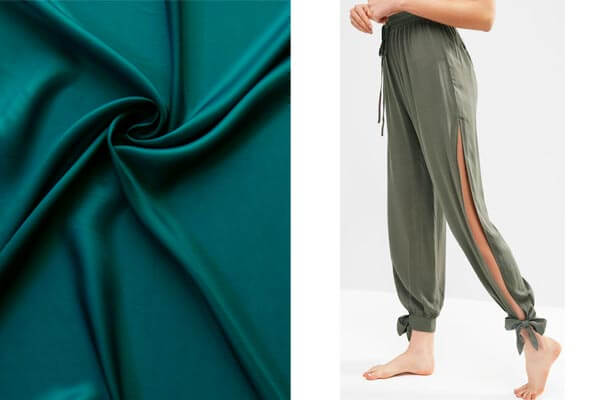
Rayon has a smooth texture similar to silk, with a soft touch and comfortable wear. It offers good breathability and moisture absorption, and is easily dyed with minimal fading. It is suitable for creating relaxed and loose styles, such as capri pants. However, its durability is average, and it is prone to deformation.
Corduroy
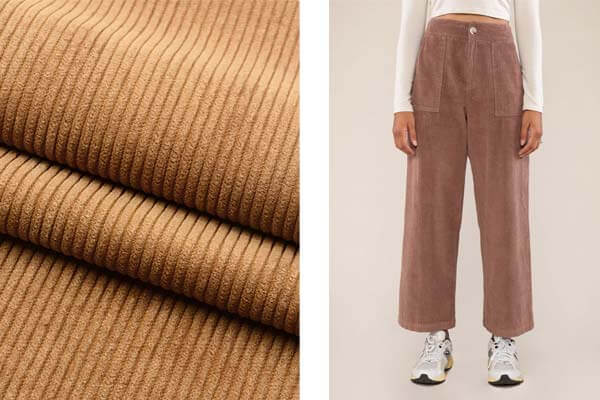
Corduroy is a synthetic fabric with high density, making it excellent for insulation. So it is a good option for making winter pants. This fabric is not easily worn or torn, resulting in pants with good durability. It’s versatile for crafting various types of pants, such as flare pants, form-fitting pants, high-waisted pants, etc.
However, the downside of this fabric is its poor breathability and low wrinkle resistance.
As a leading sourcing agent in China, JingSourcing has helped 4000+ clients source and customize products directly from China factories, including pants in different materials and styles. We have cooperated with over 200 manufacturers who are experienced in complex customization. You just tell us your requirements and we can help you deal with everything in the sourcing process.

What’s up, this weekend is good in favor of me, since this moment i am reading this wonderful informative piece of writinghere at my house.